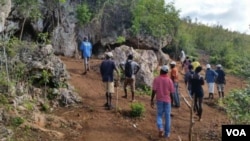When rain clouds darken the skies over this government seat in Haiti's southwestern peninsula, Roland Despeines retreats to a mountain cave. There, he and scores of other Haitians have taken shelter from storms ever since October 4, when deadly Hurricane Matthew tore up their homes and upended their lives.
Despeines is among 240 people whom the Florida-based Food for the Poor last month discovered were spending nights huddled in two caves about seven kilometers from the capital. The aid group was searching for land to plant food crops, it said in a statement on what it called a humanitarian crisis. It said the cave dwellers included 84 women and 62 children.
"Whenever the rain is about to fall, all of us come to stay here," Despeines told a VOA correspondent who made the rocky trek to the cave Friday. He spotted kerosene lamps and sheets woven from palm fronds.
Haiti's new president, Jovenel Moïse, and its prime minister, Jack Guy Lafontant, along with local officials, also visited Friday. They promised to deliver food and shelter.
The United Nations has reported that at least 70 percent of crops were destroyed in Grand'Anse, the jurisdiction in which Jérémie lies.
"The children are crying all the time because they are hungry," Despeines said. " … When a vehicle comes to the area, the people run after it," hoping for food, he added. "If a car brings a bag of rice, we cook it right away, and it isn't enough to feed all of us."
A young woman named Bernie Josee also complained of hunger: "Sometimes, visitors come to this area and they bring us food. But this week, we have nothing to eat."
The Miami Herald recently reported food was so scarce on the peninsula that some Haitians, desperate to ease hunger pangs, were eating poisonous plants.
Government workers and aid groups periodically distribute food such as rice and beans. A low-priced government-run restaurant is planned for Fond Rouge D'Ayere, a community near Jérémie, and Moïse has ordered plans for new homes.
The U.S. Agency for International Development provided emergency supplies such as plastic sheeting after the hurricane, and it partnered with a local organization to hire carpenters for home repairs.
A U.N. Development Program flash appeal for $138 million in post-hurricane aid to Haiti indicates it remains short of its goal by at least one-third.
This story was reported by VOA's Creole Service. Belenfant Magloire of VOA affiliate Radio Tele Ginen contributed from Jérémie.












